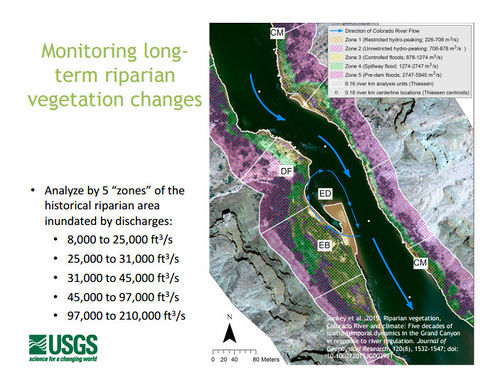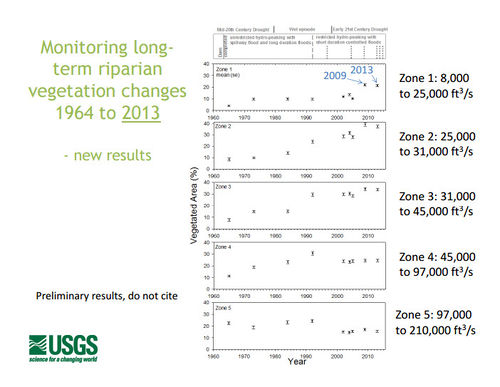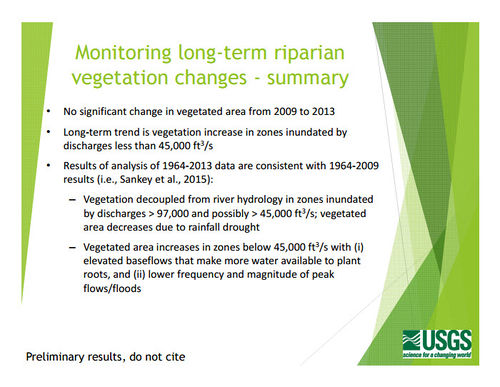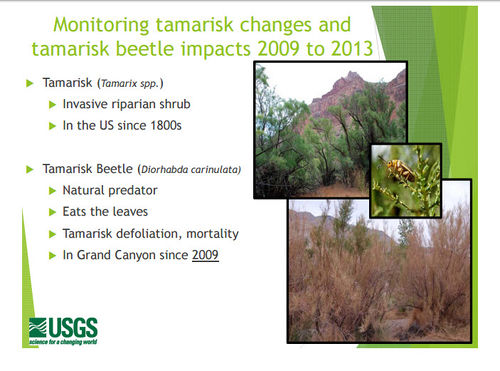Difference between revisions of "ECOSYSTEM"
Cellsworth (Talk | contribs) |
Cellsworth (Talk | contribs) |
||
| Line 1: | Line 1: | ||
| − | + | ||
__NOTOC__ __NOEDITSECTION__ | __NOTOC__ __NOEDITSECTION__ | ||
<!-- | <!-- | ||
| Line 12: | Line 12: | ||
<tr style='mso-yfti-irow:0;mso-yfti-firstrow:yes'> | <tr style='mso-yfti-irow:0;mso-yfti-firstrow:yes'> | ||
<td width=40% valign=bottom align=left style='width:2.05in;padding:0in 5.4pt 0in 5.4pt'> | <td width=40% valign=bottom align=left style='width:2.05in;padding:0in 5.4pt 0in 5.4pt'> | ||
| − | <p class=MsoNormal> | + | <p class=MsoNormal></p> |
| − | + | ||
| − | + | ||
| − | + | ||
</td> | </td> | ||
</tr> | </tr> | ||
</table> | </table> | ||
| + | |||
| + | [[Image:VegetationMonitoring.jpg|500px|center]] | ||
<!-- | <!-- | ||
| Line 65: | Line 64: | ||
|style="color:#000;"| | |style="color:#000;"| | ||
| − | + | [[Image:VegMonitoring_1964_2013.jpg|500px|center]] [http://www.usbr.gov/uc/rm/amp/amwg/mtgs/16aug24/Attach_07c.pdf] | |
| − | + | ||
| − | + | [[Image:VegMonitoring_summary.jpg|500px|center]] [http://www.usbr.gov/uc/rm/amp/amwg/mtgs/16aug24/Attach_07c.pdf] | |
| − | + | ||
| − | + | [[Image:TamariskBeetle.jpg|500px|center]] [http://www.usbr.gov/uc/rm/amp/amwg/mtgs/16aug24/Attach_07c.pdf] | |
| − | + | ||
| − | + | ||
|} | |} | ||
| Line 116: | Line 111: | ||
|style="color:#000;"| | |style="color:#000;"| | ||
| − | * | + | === General Wildlife === |
| + | *Approximately '''355 Bird''', '''89 mammal''', '''47 reptile''', '''9 amphibian''', and thousands of aquatic and terrestrial invertebrate species can be found in GCNP and GCNRA's Glen Canyon reach. (NPS CFMP-EA_pg 19) | ||
| + | |||
| + | === General Plant Species === | ||
| + | *Approximately '''129 vegetation communities''', Over '''850 species''' have been reported from GCNRA, and over '''1,750 vascular plant species''' from GCNP (NPS CFMP-EA_pg 19) | ||
| + | |||
| + | #'''Riparian communities''' are dominated by species such as coyote and seep willows, arrowweed, western honey mesquite, catclaw acacia, and exotic tamarisk with many other species present. | ||
| + | #'''Desert Scrub communities''' are dominated by species such as creosote, white bursage, brittle bush, ocotillo, four-wing saltbush, big sagebrush, ephedra, dropseed, brome grasses, and many other species. | ||
| + | #Approximately '''11%''' of flora in GCNP and GC reach is exotic. | ||
<br> | <br> | ||
|} | |} | ||
Revision as of 13:05, 16 February 2017
|
|
Riparian EcosystemsDesired Future Condition for Native Species and Biotic CommunitiesNative Species: Nonfish Biotic Communities: CRE Riparian Domain: |
| --- |
--- |
--- |
|---|



